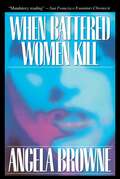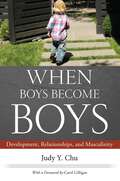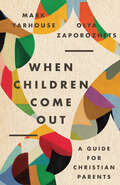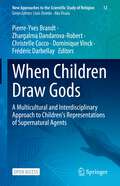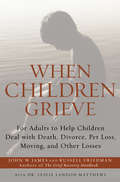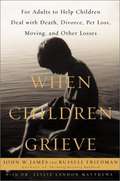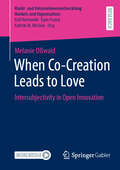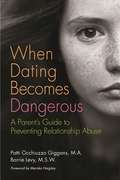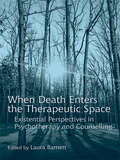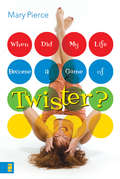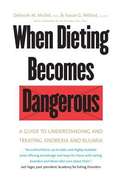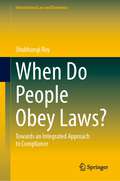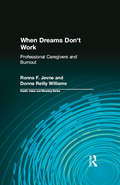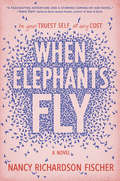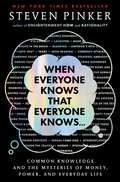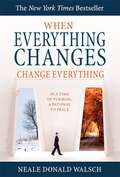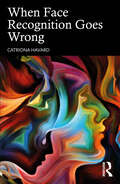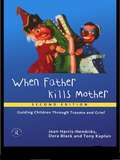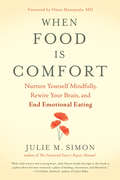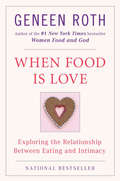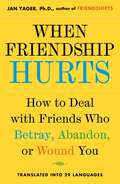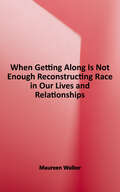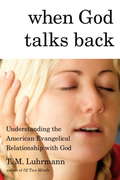- Table View
- List View
When Battered Women Kill
by Angela BrowneA compassionate look at 42 battered women who felt "locked in with danger and so desperate that they killed a man they loved"; scholarly and compelling.
When Boys Become Boys: Development, Relationships, and Masculinity
by Chu, Judy Y. Gilligan, CarolBased on a two-year study that followed boys from pre-kindergarten through first grade, When Boys Become Boys offers a new way of thinking about boys’ development. Through focusing on a critical moment of transition in boys’ lives, Judy Y. Chu reveals boys’ early ability to be emotionally perceptive, articulate, and responsive in their relationships, and how these “feminine” qualities become less apparent as boys learn to prove that they are boys primarily by showing that they are not girls. Chu finds that behaviors typically viewed as “natural” for boys reflect an adaptation to cultures that require boys to be stoic, competitive, and aggressive if they are to be accepted as “real boys.” Yet even as boys begin to reap the social benefits of aligning with norms of masculine behavior, they pay a psychological and relational price for renouncing parts of their humanity. Chu documents boys’ perceptions of the obstacles they face and the pressures they feel to conform, showing that compliance with rules of masculinity is neither automatic nor inevitable. This accessible and engaging book provides insight into ways in which adults can foster boys’ healthy resistance and help them to access a broader range of options as they seek to connect with others while remaining true to themselves.
When Children Come Out: A Guide for Christian Parents
by Mark A. Yarhouse Olya ZaporozhetsIf you are a parent wrestling with God, you are not alone.When a child comes out as LGBTQ+, Christian parents often find themselves navigating unfamiliar, unsettling terrain. Mark Yarhouse and Olya Zaporozhets, therapists and researchers with decades of experience, have written this book to provide perspective, insight, and the chance to learn from others who've shared a similar journey. Using data from studies of Christian parents of LGBTQ+ children, they deliver research-based insights and faithful wisdom that is accessible for parents, their friends, and church leaders.Yarhouse and Zaporozhets reframe the focus away from "culture war" questions that are not helpful to families in favor of practical counsel for maintaining and deepening relationships. Parents and the church leaders who care for them will benefit from understanding key developmental considerations among teenagers and emerging adults who are navigating questions around sexual and gender identity and faith.Identifying common patterns while acknowledging the uniqueness of each family, here is a book to guide parents in processing their own experiences, beliefs, and relationship with God. They will also discover techniques to reduce fear-based parenting choices and to express love, as the parent-child relationship continues to change and grow over time.When Children Come Out
When Children Draw Gods: A Multicultural and Interdisciplinary Approach to Children's Representations of Supernatural Agents (New Approaches to the Scientific Study of Religion #12)
by Dominique Vinck Frédéric Darbellay Pierre-Yves Brandt Zhargalma Dandarova-Robert Christelle CoccoThis open access book explores how children draw god. It looks at children’s drawings collected in a large variety of cultural and religious traditions. Coverage demonstrates the richness of drawing as a method for studying representations of the divine. In the process, it also contributes to our understanding of this concept, its origins, and its development. This intercultural work brings together scholars from different disciplines and countries, including Switzerland, Japan, Russia, Iran, Brazil, and the Netherlands. It does more than share the results of their research and analysis. The volume also critically examines the contributions and limitations of this methodology. In addition, it also reflects on the new empirical and theoretical perspectives within the broader framework of the study of this concept. The concept of god is one of the most difficult to grasp. This volume offers new insights by focusing on the many different ways children depict god throughout the world. Readers will discover the importance of spatial imagery and color choices in drawings of god. They will also learn about how the divine's emotional expression correlates to age, gender, and religiosity as well as strategies used by children who are prohibited from representing their god.
When Children Grieve
by John W. James Russell Friedman Dr Leslie MatthewsTo watch a child grieve and not know what to do is a profoundly difficult experience for parents, teachers, and caregivers. Yet, there are guidelines for helping children develop a lifelong, healthy response to loss.In When Children Grieve, the authors offer a cutting-edge volume to free children from the false idea of "not feeling bad" and to empower them with positive, effective methods of dealing with loss.There are many life experiences that can produce feelings of grief in a child, from the death of a relative or a divorce in the family to more everyday experiences such as moving to a new neighborhood or losing a prized possession. No matter the reason or degree of severity, if a child you love is grieving, the guidelines examined in this thoughtful book can make a difference.
When Children Grieve
by John W. James Russell FriedmanTo watch a child grieve and not know what to do is one of the most difficult experiences for parents, teachers, and caregivers. And yet, there are guidelines for helping children develop a lifelong, healthy response to loss. In When Children Grieve, John W James and Russell Friedman of the Grief Recovery Institute, along with psychotherapist Dr. Leslie Landon Matthews, have created a cutting-edge volume that will help free children from the false idea that they "shouldn't feel bad" and will empower them with positive, effective methods of dealing with loss.
When Children Grieve: For Adults to Help Children Deal with Death, Divorce, Pet Loss, Moving, and Other Losses
by John W. James Russell Friedman Leslie MatthewsTo watch a child grieve and not know what to do is a profoundly difficult experience for parents, teachers, and caregivers. Yet, there are guidelines for helping children develop a lifelong, healthy response to loss.In When Children Grieve, the authors offer a cutting-edge volume to free children from the false idea of "not feeling bad" and to empower them with positive, effective methods of dealing with loss.There are many life experiences that can produce feelings of grief in a child, from the death of a relative or a divorce in the family to more everyday experiences such as moving to a new neighborhood or losing a prized possession. No matter the reason or degree of severity, if a child you love is grieving, the guidelines examined in this thoughtful book can make a difference.
When Co-Creation Leads to Love: Intersubjectivity in Open Innovation (Markt- und Unternehmensentwicklung Markets and Organisations)
by Melanie OßwaldInnovating organizations struggle to select suitable co-creators and their ideas. Co-creating market relevance is challenging, as one's own contributions often lead to evaluation biases, such as the &“IKEA Effect – When Labor Leads to Love,&” the foundation of this book. Transcending organizational boundaries requires transcending individual evaluation. Intersubjectivity is essential for this step. This work suggests using intersubjectivity as a concept for more efficient open innovation beyond individual biases. The exploratory sequential research design aims to develop a comprehensive understanding of evaluation biases and the concept of intersubjectivity in open innovation. It begins with qualitative inquiry, including a narrative literature review and expert interviews, followed by the identification and empirical testing of novel intersubjectivity-related variables through laboratory and field experiments. In addition to its theoretical implications, this book presents a typology of contexts requiring intersubjectivity and provides a working model to guide organizations and intermediaries in their co-creation practices.
When Crisis Strikes: 5 Steps to Heal Your Brain, Body, and Life from Chronic Stress (Amen Clinic Library)
by Jennifer Love Kjell Tore Hovik&“An essential roadmap for our stressful world.&” —David Perlmutter, MD, #1 New York Times bestselling author YOUR BRAIN&’S GREATEST ENEMY? CHRONIC STRESS. LEARN HOW TO REGAIN CONTROL, LIFE BALANCE, AND WELL-BEING. FROM THE RENOWNED AMEN CLINICS Stress is an unfortunate fact of modern life, and when those stressors are catastrophic—divorce, illness, caregiving, loss—a brain under stress becomes a brain in crisis. In this invaluable guide, award-winning psychiatrist Dr. Jennifer Love and neuropsychologist Dr. Kjell Hovik explore how to heal the damage that prolonged stress can do to your brain and your health. In When Crisis Strikes you&’ll learn how to prevent these side effects from hijacking your daily life. • Discover how your brain works with your body&’s natural stress response system. • Learn how mental and emotional cues cause physical reactions like muscle tension, pain, lowered sex drive, and more. • Practice the five steps to relieve a stressor&’s toll on your mind and your body. • Utilize the tools to deal with any life crisis. When Crisis Strikes provides hope and healing for everyone who has experienced the often-crushing weight of chronic stress. &“An essential roadmap for our stressful world.&” —David Perlmutter, MD, #1 New York Times bestselling author &“Drs. Love and Hovik will show you the science of your stress response, the impact on your mind and body, and practical steps to feel better and come through it stronger."—Mark Hyman, MD, #1New York Times bestselling author &“Charming, poignant, and profound. In the midst of an unprecedented global crisis that the COVID pandemic is, readers will find the book full of deep insights and practical advice.&” —Elkhonon Goldberg, PhD, Director, Luria Neuroscience Institute and Clinical Professor of Neurology, NYU Grossman School of Medicine
When Dating Becomes Dangerous: A Parent's Guide to Preventing Relationship Abuse
by Patricia Occhiuzzo Giggans Mariska Hargitay Barrie LevySend your teenager out into the dating world equipped with the knowledge, strength, and communication skills to walk away from abusive relationships--and to develop healthy ones.Send your teenager out into the dating world equipped with the knowledge, strength, and communication skills to walk away from relationships that are abusive--and to develop healthy ones.As our kids grow older and they start asserting their independence, we worry about their safety and well being. And when it comes to dating and intimacy, it is hard to know how to protect them when a would-be gentle relationship turns violent, be it verbally or physically. The fact is that as many as one in four high school and college-aged youth are affected by an abusive relationship. So, how do we as parents protect our kids from becoming another statistic? And how do we give them the self-assurance to leave a dangerous situation?In this informative guide for parents, Barry Levy and Patricia Occhiuzzo Giggans, both experts in relationship violence, draw on their professional experience to provide guidance for getting through the relationship challenges kids, both gay and straight, face today. Here you'll discover: How to give your teen the skills to encourage healthy relationshipsWhy many teenagers hide their abusive relationshipHow to recognize the warning signs of dating violence, including cyber abuseWhat to do if your child is the abuser, and when girls are the perpetrator of abuse
When Death Enters the Therapeutic Space: Existential Perspectives in Psychotherapy and Counselling
by Laura BarnettAlthough it is a natural and inescapable part of life, death is a subject that is often neglected in psychotherapeutic literature and training. In When Death Enters the Therapeutic Space Laura Barnett and her contributors offer us insights into working with mortality in the therapeutic encounter. Taking an existential perspective, the book brings together a variety of client groups, all of whom have experienced a confrontation with mortality, and encourages the reader to engage with and reflect upon the subject of death. Although this may initially evoke anxiety and distress, Barnett and her contributors introduce the reader to the 'vitality of death' (Koestenbaum): an energy and focus that can come from confronting our greatest fears and anxieties, including the anxiety aroused by our own mortality. Topics covered include: philosophical roots and principal approaches to existential therapy health related issues including cancer, HIV and Intensive Care surviving violent trauma creating a safe space for the client short prognosis and palliative care bereavement. When Death Enters the Therapeutic Space presents therapists with an understanding of what it means to experience such traumas and prepares them for helping the client. It will be useful for trainee counsellors and experienced therapists alike.
When Did My Life Become a Game of Twister?
by Mary PierceYou started out knowing just how the game of life would go'so how did it become a game for contortionists, twisting you in every direction in response to the pressures and heartbreaks of life? Offering humor and hope, Mary Pierce helps women untwist with laughter, encouragement, and inspiration.
When Dieting Becomes Dangerous: A Guide to Understanding and Treating Anorexia and Bulimia
by Deborah Marcontell Michel Susan G. Willard Arthur H. CrispWhat constitutes an eating disorder, and why does someone develop one? What can family, friends, and professionals do to help an individual suffering from a potentially devastating eating problem? This invaluable primer on anorexia and bulimia is written for patients and the people who care about them. In simple, straightforward language, two experts in the field describe the symptoms and warning signs of eating disorders, explain their presumed causes and complexities, and suggest effective treatments. Book jacket.
When Do People Obey Laws?: Towards an Integrated Approach to Compliance (International Law and Economics)
by Shubhangi RoyThis book examines the intricate dynamics of when individuals adhere to laws, taking into account the context in which laws attempt to shape human behavior. While existing literature touches upon various reasons why people comply with laws, the book focuses on a critical question which has been missing from the discussion: when do people obey laws? By treating law as a form of social communication, it develops an integrated framework to answer this question. It explores how social, psychological, and institutional conditions shape compliance decisions of individuals. What does a law signify? When does the compulsion to obey arise? When do individuals comply out of a fear for legal sanctions or social repercussions? Why do some laws have high symbolic values and others fail despite harsh punishments? The book unveils the contextual intricacies that underlie obedience to law. It challenges conventional wisdom and offers a fresh perspective on the power and limitationsof law in shaping human behavior. For scholars and academics seeking a deeper understanding of legal compliance and role of law in shaping behaviors, this book will be an indispensable resource.
When Dreams Don't Work: Professional Caregivers and Burnout (Death, Value and Meaning Series)
by Ronna F Jevne Donna Reilly WilliamsWhen Dreams Don't Work: Professional Caregivers and Burnout presents a fresh perspective on burnout. This book examines the origins and qualities of the dreams (visions) of professional caregivers and the ways those very qualities are risk factors for burnout. ""When Dreams Don't Work: Professional Caregivers and Burnout"" also looks at the institutions in which professional caregivers (medical, educational, pastoral, law enforcement, and firefighting) invest their professional dreams, and how those institutions contribute to the burnout process.
When Elephants Fly
by Nancy Richardson FischerDon’t miss one of the most heartwarming young adult novels of the year. Perfect for fans of Water for Elephants, Wonder and All the Bright Places, When Elephants Fly shows that how we choose to live our lives matters, and that there are some battles worth fighting even if it means losing yourself. T. Lily Decker is a high school senior with a twelve-year plan: avoid stress, drugs, alcohol and boyfriends, and take regular psych quizzes administered by her best friend, Sawyer, to make sure she’s not developing schizophrenia.Genetics are not on Lily’s side. When she was seven, her mother, who had paranoid schizophrenia, tried to kill her. And a secret has revealed that Lily’s odds are even worse than she thought. Still, there’s a chance to avoid triggering the mental health condition, if Lily can live a careful life from ages eighteen to thirty, when schizophrenia most commonly manifests.But when a newspaper internship results in Lily witnessing a mother elephant try to kill her three-week-old calf, Swifty, Lily can’t abandon the story or the calf. With Swifty in danger of dying from grief, Lily must choose whether to risk everything, including her sanity and a first love, on a desperate road trip to save the calf’s life, perhaps finding her own version of freedom along the way.
When Everyone Knows That Everyone Knows . . .: Common Knowledge and the Mysteries of Money, Power, and Everyday Life
by Steven PinkerFrom one of the world’s most celebrated intellectuals, a brilliantly insightful work that explains how we think about each other’s thoughts about each other’s thoughts, ad infinitum. It sounds impossible, but Steven Pinker shows that we do it all the time. This awareness, which we experience as something that is public or “out there,” is called common knowledge, and it has a momentous impact on our social, political, and economic lives. <P><P> Common knowledge is necessary for coordination, for making arbitrary but complementary choices like driving on the right, using paper currency, and coalescing behind a political leader or movement. It’s also necessary for social coordination: everything from rendezvousing at a time and place to speaking the same language to forming enduring relationships of friendship, romance, or authority. Humans have a sixth sense for common knowledge, and we create it with signals like laughter, tears, blushing, eye contact, and blunt speech. <P><P> But people also go to great lengths to avoid common knowledge—to ensure that even if everyone knows something, they can’t know that everyone else knows they know it. And so we get rituals like benign hypocrisy, veiled bribes and threats, sexual innuendo, and pretending not to see the elephant in the room. <P><P> Pinker shows how the hidden logic of common knowledge can make sense of many of life’s enigmas: financial bubbles and crashes, revolutions that come out of nowhere, the posturing and pretense of diplomacy, the eruption of social media shaming mobs and academic cancel culture, the awkwardness of a first date. Artists and humorists have long mined the intrigues of common knowledge, and Pinker liberally uses their novels, jokes, cartoons, films, and sitcom dialogues to illuminate social life’s tragedies and comedies. <P><P> Along the way he answers questions like: Why do people hoard toilet paper at the first sign of an emergency? Why are Super Bowl ads filled with ads for crypto? Why, in American presidential primary voting, do citizens typically select the candidate they believe is preferred by others rather than their favorite? Why did Russian authorities arrest a protester who carried a blank sign? Why is it so hard for nervous lovers to say goodbye at the end of a phone call? Why does everyone agree that if we were completely honest all the time, life would be unbearable? <P><P> Consistently riveting in explaining the paradoxes of human behavior, When Everyone Knows That Everyone Knows… invites us to understand the ways we try to get into each other’s heads and the harmonies, hypocrisies, and outrages that result. <P><P> <B>New York Times Bestseller</B>
When Everything Changes, Change Everything
by Neale Donald WalschThe one constant in life and the most difficult thing to face is change. Death, the end of a relationship, the loss of a job, a health or financial emergency, or even a crisis of faith are all circumstances that each of us faces at various points in our lives. In each instance, the challenges that we all must confront are embracing change and realizing that new circumstances represent not just loss but the possibility of growth. This is a book for those dealing with tough times, as well as the myriad Neale Donald Walsch fans.
When Face Recognition Goes Wrong
by Catriona HavardWhen Face Recognition Goes Wrong explores the myriad ways that humans and machines make mistakes in facial recognition. Adopting a critical stance throughout, the book explores why and how humans and machines make mistakes, covering topics including racial and gender biases, neuropsychological disorders, and widespread algorithm problems. The book features personal anecdotes alongside real-world examples to showcase the often life-changing consequences of facial recognition going wrong. These range from problems with everyday social interactions through to eyewitness identification leading to miscarriages of justice and border control passport verification.Concluding with a look to the future of facial recognition, the author asks the world’s leading experts what are the big questions that still need to be answered, and can we train humans and machines to be super recognisers? This book is a must-read for anyone interested in facial recognition, or in psychology, criminal justice and law.
When Father Kills Mother: Guiding Children Through Trauma and Grief
by Jean Harris-Hendriks Dora Black Tony KaplanChildren bereaved by the death of one parent at the hands of the other, almost always the father, in effect lose both parents, and are often forgotten in the midst of such dramatic situations. Reflecting the increased interest in child protection and child law systems, this second edition of When Father Kills Mother brings to public knowledge, in amplified form information about the effects of psychological trauma and bereavement on children. By combining knowledge about bereavement with that of post-traumatic stress disorder, the book remains informative and essential reading for all those involved in the field, both professionally and personally.
When Food Is Comfort: Nurture Yourself Mindfully, Rewire Your Brain, and End Emotional Eating
by Julie M. SimonLearn Inner Nurturing and End Emotional Eating If you regularly eat when you&’re not truly hungry, choose unhealthy comfort foods, or eat beyond fullness, something is out of balance. Recent advances in brain science have uncovered the crucial role that our early social and emotional environment plays in the development of imbalanced eating patterns. When we do not receive consistent and sufficient emotional nurturance during our early years, we are at greater risk of seeking it from external sources, such as food. Despite logical arguments, we have difficulty modifying our behavior because we are under the influence of an emotionally dominant part of the brain. The good news is that the brain can be rewired for optimal emotional health. When Food Is Comfort presents a breakthrough mindfulness practice called Inner Nurturing, a comprehensive, step-by-step program developed by an author who was herself an emotional eater. You&’ll learn how to nurture yourself with the loving-kindness you crave and handle stressors more easily so that you can stop turning to food for comfort. Improved health and self-esteem, more energy, and weight loss will naturally follow.
When Food Is Love: Exploring the Relationship Between Eating and Intimacy
by Geneen RothDrawing on her own painful personal experiences, as well as the candid stories of those she has helped in her seminars, Roth examines the crucial issues that surround emotional eating: need for control, dependency on melodrama, desire for what is forbidden, and the belief that one wrong move can mean catastrophe.<P><P> She shows why many people overeat in an attempt to satisfy their emotional hunger, and why weight loss frequently just uncovers a new set of problems. But her welcome message is that change is possible. This book will help readers break destructive, self-perpetuating patterns and learn to satisfy all the hungers--physical and emotional--that make us human.
When Friendship Hurts: How to Deal with Friends Who Betray, Abandon, or Wound You
by Jan Yager"HOW COULD YOU DO THAT TO ME?" We've all had friendships that have gone bad. Whether it takes the form of a simple yet inexplicable estrangement or a devastating betrayal, a failed friendship can make your life miserable, threaten your success at work or school, and even undermine your romantic relationships. Finally there is help. In When Friendship Hurts, Jan Yager, recognized internationally as a leading expert on friendship, explores what causes friendships to falter and explains how to mend them -- or end them. In this straightforward, illuminating book filled with dozens of quizzes and real-life examples, Yager covers all the bases, including: The twenty-one types of negative friends -- a rogues' gallery featuring such familiar types as the Blood-sucker, the Fault-finder, the Promise Breaker, and the Copycat How to recognize destructive friends as well as how to find ideal ones The e-mail effect -- how electronic communication has changed friendships for both the better and the worse The misuse of friendship at work -- how to deal with a co-worker's lies, deceit, or attempts at revenge How to stop obsessing about a failed friendship And much more The first highly prescriptive book to focus on the complexities of friendship, When Friendship Hurts demonstrates how, why, and when to let go of bad friends and how to develop the positive friendships that enrich our lives on every level. For everyone who has ever wondered about friends who betray, hurt, or reject them, this authoritative book provides invaluable insights and advice to resolve the problem once and for all.
When Getting Along is not Enough: Reconstructing Race in Our Lives and Relationships
by Maureen Walker“Using anecdotes from her psychology practice, Walker provides a way for educators and social service professionals to enter into cross-racial discussions about race and racial relations. She identifies skills that are essential for repairing the damage wrought by racism and provides exercises to stimulate group conversations in staff development, classrooms, and workplace training”-- Provided by publisher.
When God Talks Back: Understanding the American Evangelical Relationship with God
by T. M. LuhrmannHow does God become and remain real for modern evangelicals? How are rational, sensible people of faith able to experience the presence of a powerful yet invisible being and sustain that belief in an environment of overwhelming skepticism? T. M. Luhrmann, an anthropologist trained in psychology and the acclaimed author of Of Two Minds, explores the extraordinary process that leads some believers to a place where God is profoundly real and his voice can be heard amid the clutter of everyday thoughts. While attending services and various small group meetings at her local branch of the Vineyard, an evangelical church with hundreds of congregations across the country, Luhrmann sought to understand how some members were able to communicate with God, not just through one-sided prayers but with discernable feedback. Some saw visions, while others claimed to hear the voice of God himself. For these congregants and many other Christians, God was intensely alive. After holding a series of honest, personal interviews with Vineyard members who claimed to have had isolated or ongoing supernatural experiences with God, Luhrmann hypothesized that the practice of prayer could train a person to hear God's voice--to use one's mind differently and focus on God's voice until it became clear. A subsequent experiment conducted between people who were and weren't practiced in prayer further illuminated her conclusion. For those who have trained themselves to concentrate on their inner experiences, God is experienced in the brain as an actual social relationship: his voice was identified, and that identification was trusted and regarded as real and interactive. Astute, deeply intelligent, and sensitive, When God Talks Back is a remarkable approach to the intersection of religion, psychology, and science, and the effect it has on the daily practices of the faithful.From the Hardcover edition.
